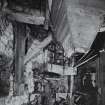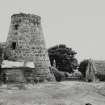Pricing Change
New pricing for orders of material from this site will come into place shortly. Charges for supply of digital images, digitisation on demand, prints and licensing will be altered.
Carluke, Chapel Street, High Mill
Windmill (18th Century)
Site Name Carluke, Chapel Street, High Mill
Classification Windmill (18th Century)
Alternative Name(s) Carluke Windmill
Canmore ID 46702
Site Number NS85SW 15
NGR NS 84935 50778
Datum OSGB36 - NGR
Permalink http://canmore.org.uk/site/46702
- Council South Lanarkshire
- Parish Carluke
- Former Region Strathclyde
- Former District Clydesdale
- Former County Lanarkshire
NS85SW 15 84935 50778
(Location cited as NS 849 508). High Mill, built 1797. A tapering 3-storey rubble tower of circular cross section, with a later 2-storey ashlar addition, a brick square-section chimney and outbuildings at the rear. There is the condensor of a steam engine, made by Easton & Anderson of London, and most of a Tangye gas engine. The interior of the tower is not readily accessible, but is believed to contain some of the mill-work, and is thus the most complete Scottish windmill.
J R Hume 1976.
Built as a grain mill shortly after 1797, this three-storeyed circular windmill-tower stands complete to the original wall-head some 9.9m above ground. The walls have a pronounced external batter, the overall diameter at the top (4.27m) being only slightly more than half the basal diameter of 8.23m. At the date of survey (1970), adjacent ranges on the E of the tower contained the remains of a later kiln, threshing-machine and an engine-house, while on the W a two-storeyed dwelling-house and ancillary buildings were grouped around a courtyard. The mill was converted to steam power in about the middle of the 19th century, and subsequently a gas-engine was used. At the wall-head a masonry channel with indented sockets is all that now remains of the kerb of the original rotating cap.
G D Hay and G P Stell 1986.
Tapering 3 storey rubble tower of circular cross section, the top and sails missing. Attached a mid 19th century double pile, 2-storey squared rubble range housing the former threshing mill in the eastern part, a brick lined kiln and loft in the western part with machinery below the loft. To the northeast a square section brick chimney with boiler house and outbuildings, the latter partly ruinous.
The tower stands complete to the original wall-head some 9.9m above ground. The mill was converted to steam power in about the middle of the 19th century, and subsequently a gas-engine was used. At the wall-head a masonry channel with indented sockets is all that now remains of the kerb of the original rotating cap. High Mill is the most complete Scottish windmill. It was working until the 1930s. (Historic Scotland)
Publication Account (1986)
Built as a grain mill shortly after 1797, this three-storeyed circular windmill-tower stands complete to the original wall-head some 32 ft 6 in (9.9m) above ground. The walls have a pronounced external batter, giving the tower an unusually sturdy profile, the overall diameter at the top (14 ft; 4.27m) being only slightly more than half the basal diameter of 27 ft (8.23m). At the date of survey, adjacent ranges on the E of the tower contained the remains of a later kiln, threshing-machine and an engine-house, while on the W a two-storeyed dwelling-house and ancillary buildings were grouped around a courtyard.
The interior of the tower retains much machinery and the principal drive-shaft. Previous investigators were misled into believing that some of the mechanism may have been original, but detailed examination showed that the shaft and the stones were driven through gearing from below, not from above, and none of the components was demonstrably original. Some of the timbers used for framing the machinery may have been in secondary use, but, to judge from the wall-sockets, the original floor-levels appear to have been retained. The mill had been converted to steam-power in about the middle of the 19th century, and subsequently a gas-engine was used . At the wall-head a masonry channel with indented sockets is all that now survives of the kerb of the original rotating cap.
Information from ‘Monuments of Industry: An Illustrated Historical Record’, (1986).
Archaeological Evaluation (September 2018 - October 2018)
NS 84935 50778 A desk-based study and site visit, were undertaken, in September and October 2018, on land surrounding Carluke High Mill which dates to 1797. The historic core of Carluke lies just to the south of High Mill and has a rich history dating back to at least the 14th century. Previous discoveries of prehistoric urns and beaker pottery in the general area suggest earlier activity as does a series of probable Roman roads which run through the landscape. The walkover revealed no upstanding archaeological remains other than those relating to the High Mill.
Archive: NRHE (intended)
Funder: Carluke Development Trust
Steve Black – Northlight Heritage
(Source: DES Vol 20)




















































































